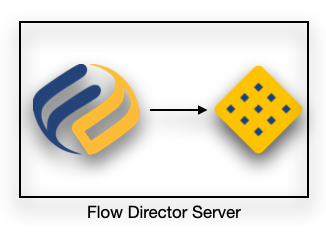Installation / Upgrade
Upgrade (Since 5.0.0)
To upgrade an existing Flow Director on premise installation to a new release, download and unpack the new release. Then stop the old release.
From the new release script directory call:
./upgrade [-q] <old release path>(-q will run this script in quite mode)
This script copies all necessary files from the old release to the new one. After running it, simply start the new release—all apps and licenses will already be in place.
For Docker installations, nothing changes: just pull the new image, update your configuration if necessary, and restart the container.
Bundled GraalVM (Since 4.2.0)
Flow Director comes bundled with GraalVM CE. This means there are different distributions available, tailored for various operating systems and processor architectures.
Modes of Operation
You can operate Flow Director in two modes:
Embedded
In this mode, Flow Director launches an embedded SwiftMQ CE router called flowdirector to deploy and execute flows.

Flight
Here, Flow Director does NOT launch an embedded router but connects to an existing SwiftMQ router that can also be a SwiftMQ HA router.

Run Flow Director in Embedded Mode (local)
After unpacking the distribution, change to the scripts directory (open a terminal there) and execute:
./startserverRun Flow Director in Flight Mode (local)
After unpacking the distribution, change to the scripts directory (open a terminal there) and execute:
./startflight [<hostname> <port> <JMS username> <JMS password> <TLS true/false> <keepalive secs> [<hostname2> <port2>]]Parameter | Meaning | Default |
|---|---|---|
| Hostname of the SwiftMQ router. |
|
| JMS port of the SwiftMQ router. |
|
| Name of the JMS user. |
|
| Password of the JMS user. |
|
| Use a secure TLS connection. |
|
| SMQP keepalive interval of the JMS listener. |
|
| Hostname of the 2nd HA instance. | |
| JMS port of the 2nd HA instance. |
If you don’t pass any parameter to the script, it will use the above-mentioned default values.
Authentication
Flow Director in flight mode connects as a normal JMS client. If you have authentication enabled in the SwiftMQ router, you need to add grants for all queues and topics that are used from Flow Director and Flow Director Apps.
This is not possible.
You need to switch your authentication to “password check only”:
<swiftlet name="sys$authentication" authentication-enabled="true" password-check-only="true">This will only check the password of a client but not the grants.
If that is not possible due to security or access concerns, you need to use Flow Director in embedded mode where it starts its own embedded router flowdirector. Then connect this router to your other router(s).
Run Flow Director in Embedded Mode (Docker)
Create a new directory flowdirector and open a terminal there. Flow Director will create 2 sub-directories to store data. Then run these commands.
Unix/Linux/macOS:
docker run -d --name flowdirector \
-p 8080:8080 \
-p 4001:44001 \
-p 4100:44100 \
-p 5672:45672 \
-p 1883:41883 \
-v `pwd`/data/apps:/flowdirector/apps \
-v `pwd`/data/log:/flowdirector/log \
-v `pwd`/data/config:/flowdirector/config \
-v `pwd`/router/data:/flowdirector/router/data \
flowdirector/fdserver:latestWindows:
docker run -d --name flowdirector \
-p 8080:8080 \
-p 4001:44001 \
-p 4100:44100 \
-p 5672:45672 \
-p 1883:41883 \
-v "%cd%/data/apps":/flowdirector/apps \
-v "%cd%/data/log":/flowdirector/log \
-v "%cd%/data/config":/flowdirector/config \
-v "%cd%/router/data":/flowdirector/router/data \
flowdirector/fdserver:latestIt creates Flow Director in Embedded mode, listening on port 8080 for HTTP, 4001 on JMS, 5672 on AMQP, 1883 on MQTT, and 4100 on Routing connections.
Run Flow Director in Flight Mode (Docker)
Create a new directory flowdirector and open a terminal there. Flow Director will create a data sub-directories to store data. Then run these commands.
Unix/Linux/macOS:
docker run -d --name flowdirector \
-p 8080:8080 \
-e FD_LIGHT=true \
-e FD_LIGHT_HOSTNAME=<hostname> \
-e FD_LIGHT_PORT=<port> \
-e FD_JMS_USERNAME=<JMS username> \
-e FD_JMS_PASSWORD=<JMS password> \
-e FD_LIGHT_TLS=<TLS true/false> \
-e FD_LIGHT_KEEPALIVE=<keepalive secs> \
-e FD_LIGHT_HOSTNAME2=<hostname2> \
-e FD_LIGHT_PORT2=<port2> \
-v `pwd`/data/apps:/flowdirector/apps \
-v `pwd`/data/log:/flowdirector/log \
-v `pwd`/data/config:/flowdirector/config \
flowdirector/fdserver:latestWindows:
docker run -d --name flowdirector \
-p 8080:8080 \
-e FD_LIGHT=true \
-e FD_LIGHT_HOSTNAME=<hostname> \
-e FD_LIGHT_PORT=<port> \
-e FD_JMS_USERNAME=<JMS username> \
-e FD_JMS_PASSWORD=<JMS password> \
-e FD_LIGHT_TLS=<TLS true/false> \
-e FD_LIGHT_KEEPALIVE=<keepalive secs> \
-e FD_LIGHT_HOSTNAME2=<hostname2> \
-e FD_LIGHT_PORT2=<port2> \
-v "%cd%/data/apps":/flowdirector/apps \
-v "%cd%/data/log":/flowdirector/log \
-v "%cd%/data/config":/flowdirector/config \
flowdirector/fdserver:latestYou need to fill the respective values of the environment variables (-e) accordingly. You can omit FD_LIGHT_HOSTNAME2 and FD_LIGHT_PORT2 if you don't use a SwiftMQ HA router.
Keep in mind: If the SwiftMQ router you want to connect to runs on the same host, neither use localhost nor 127.0.0.1 as hostname as it would point to the internal localhost of the Docker container.
It creates Flow Director in Flight mode, listening on port 8080 for HTTP. All other listeners are provided from the external SwiftMQ router.
